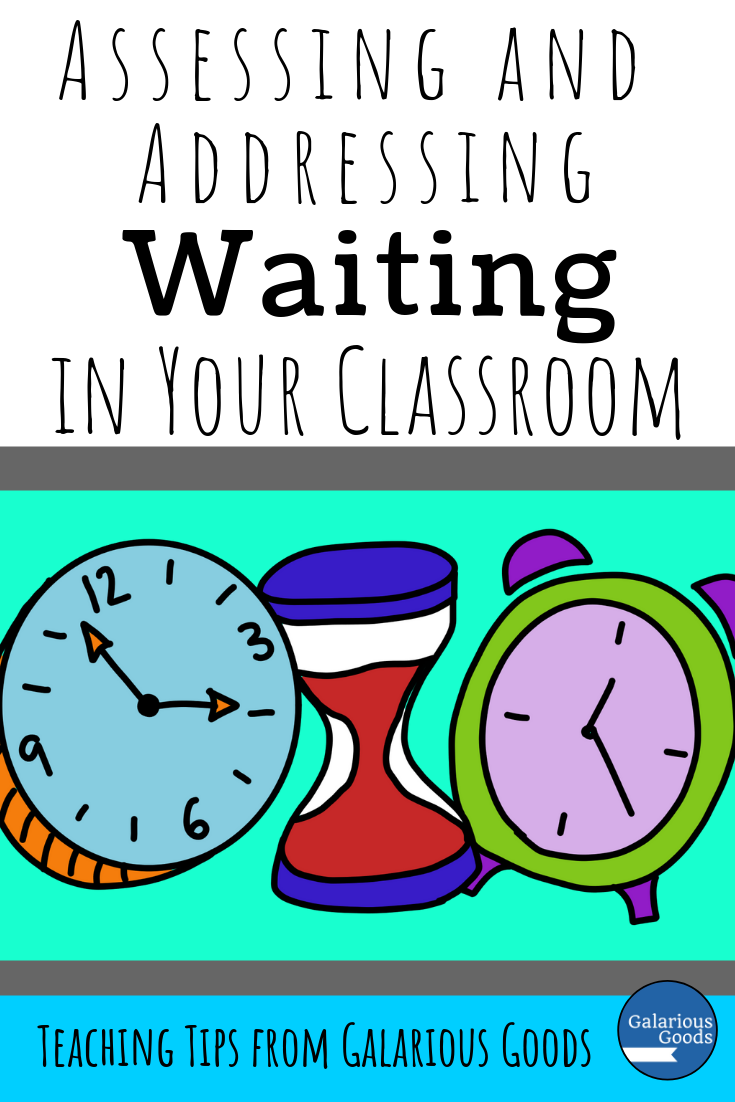Assessing and Addressing Waiting in Your Classroom
/For many children, waiting for their classmates to finish working so they can move on is a frustrating - and frustratingly common - occurrence. Researcher have even found that some students spend as much as 50% of their learning time waiting for other students.
How can we assess the waiting in our classroom? And how can we address it so our students are learning as much as possible?
1. Be aware of the waiting in your classroom
It’s hard to address waiting in your classroom if you’re not really sure when or where it’s happening. Classrooms are busy places and it can be hard to be sure what is happening unless you’re making a point of focusing on it. Keep a record of what waiting happens over a week. You might want to record
The inevitable waiting. Waiting for assemblies, specialist teachers, technical equipment to work, students to line up to return to class or move around school. You can do things to reduce some of this, but there’s always going to be some waiting - and it’s ok for your students to know this.
Which students are finishing early. Some of the students might tell you if they finish early, others might just finish and wait. Keep an eye out for them, or ask your students to let you know if they finish early.
If there are students who are finishing with the rest of the class, but they probably could be finishing quicker. If students have become accustomed to getting more work when they finish early, they may have learned to slow themselves down to avoid the extra work. These students can be hard to spot, but keep a note of any suspicions you have. Especially look out for students who are inserting ‘non-work’ time into their work time and still finishing on time - although their interruptions might be distracting, it might be their way of delaying their finish.
Students who are finishing early, but could probably be working at a higher level. It’s good to have a record of who might be ‘rushing’ through the work and may need some slowing down strategies and thinking time.
Which subjects have more waiting time. Are students waiting more in maths? Or reading? Do you have lower number of students waiting when you do handwriting? Make a record of this to help you plan future lessons.
Be kind to yourself. If you get a lot of information it can be overwhelming. But it’s ok to pick one or two areas to work on first. It’s also ok to come back and undertake this reflection at a later time - especially if you’ve made changes. You may see some great improvements and you might also find some other areas to work on.
2. Plan to differentiate - combat waiting before it begins
The best way to avoid frustrating waiting in the classroom is to plan for all your students to be as engaged in learning as much as possible! This kind of differentiation is not always easy, though. Here’s a few things you might like to include in your planning.
Pre-assess when you can. If you’re approaching a new concept in reading, mathematics or science, it may be useful to offer a short pre-assessment. This allows you to see where students already have a good understanding of the concept - and where there are gaps in knowledge. The work can then be targeted to the students in your class for the best learning for all of them, and it may help you put together some temporary groups to work together.
Plan to use open-ended activities with different possibilities. Open-ended activities are a great way to allow all students to be engaged and show understanding of a concept. For example, instead of (or as well as) offering a page of maths problems where students add 10, ask them what happens if they add 10 to different numbers. Students can practice their skills and find patterns.
You can also offer students a range of activities to complete - nominating which ones are ‘must-dos’ and which ones they can choose to do when the ‘must-dos’ are completed. (You can read more, and get free resources from this great post from Top Teaching Tasks)
Think Sideways. What is the learning outcome? What would it look like if students dug a little deeper into that outcome? For example:
if the class are doing addition problems, the students who have finished can explore matching the addition problems to ‘turn around’ subtraction problems
if the class are reading an information sheet, the students who have finished reading can find the most important vocabulary (and rank importance?) or create a diagram of what they have read.
if students are working on reading sight words, the students who have finished can work on adding new letters or swapping letters to make different words
Try to make as many of your differentiated activities transferable to other activities, while still being effective. Creating a ‘tool-kit’ of differentiation for quick finishers will make it easier to make it part of your planning.
3. Be Prepared for Surprise Finishes
As prepared as you might be, you’ll probably still have time when students finish early. Here’s a few things you can try to work with that
Develop a classroom culture of ‘is it my best work?’ This allows all students to demonstrate the best work they can possibly do in the classroom, but also gives quick finishers something meaningful to do when they have ‘finished’. Going back and revising work is an important skill for all students to develop. Ask students to find 3 areas where they can improve their work and ask them to reflect on why they think those areas can be improved. It is possible that they won’t find anything, but it’s important for them to know that even adults (such as authors) go back and revise and improve their work - and a thoughtful way to use time.
Ask students how they would explain the concept or how to solve the problem to someone else. They might create a written piece, a drawing, a diagram, a verbal explanation - even a podcast or a video of their explanation.
Ask students to create their own related problems. If they’ve finished all the comprehension questions for a chapter, what questions would they ask? If they’re finished with a fractions problem, how would they create one? This allows you another way to see the depth of their understanding, while being meaningful work.
Keep reading and games on technology as a last resort. If there’s really no other way to fill in the waiting time, you may need these to turn to. Think about setting a time limit on them (assess when you’ll be moving other students on) so students know when they need to put the book down or turn off the game. And make sure there’s time in your schedule for all students to enjoy the games or reading time so there’s no resentment building against those fast finishers.
Related posts to read:
5 Ways to Plan and Differentiate for Young Gifted Readers: Part One
5 Ways to Plan and Differentiate for Young Gifted Readers: Part Two
The What Would You Take? Project - A Hands On Classroom Activity
4 Ways to Use Amazing Songs To Make Your Lessons More Attractive
No More Holiday Busywork - Creating Thoughtful Holiday Lessons
















